30 search results - page 2 / 6 » Using background knowledge to rank itemsets |
BMCBI
2005
13 years 5 months ago
2005
Background: Interpretation of simple microarray experiments is usually based on the fold-change of gene expression between a reference and a "treated" sample where the t...
BMCBI
2006
13 years 5 months ago
2006
Background: Existing biological databases support a variety of queries such as keyword or definition search. However, they do not provide any measure of relevance for the instance...
ICEIS
2009
IEEE
14 years 1 days ago
2009
IEEE
Traditional approaches for mining generalized association rules are based only on database contents, and focus on exact matches among items. However, in many applications, the use ...
SIGIR
2010
ACM
13 years 9 months ago
2010
ACM
We focus on the task of target detection in automatic link generation with Wikipedia, i.e., given an N-gram in a snippet of text, find the relevant Wikipedia concepts that explai...
BMCBI
2004
13 years 5 months ago
2004
Background: The identification of relevant biological features in large and complex datasets is an important step towards gaining insight in the processes underlying the data. Oth...

